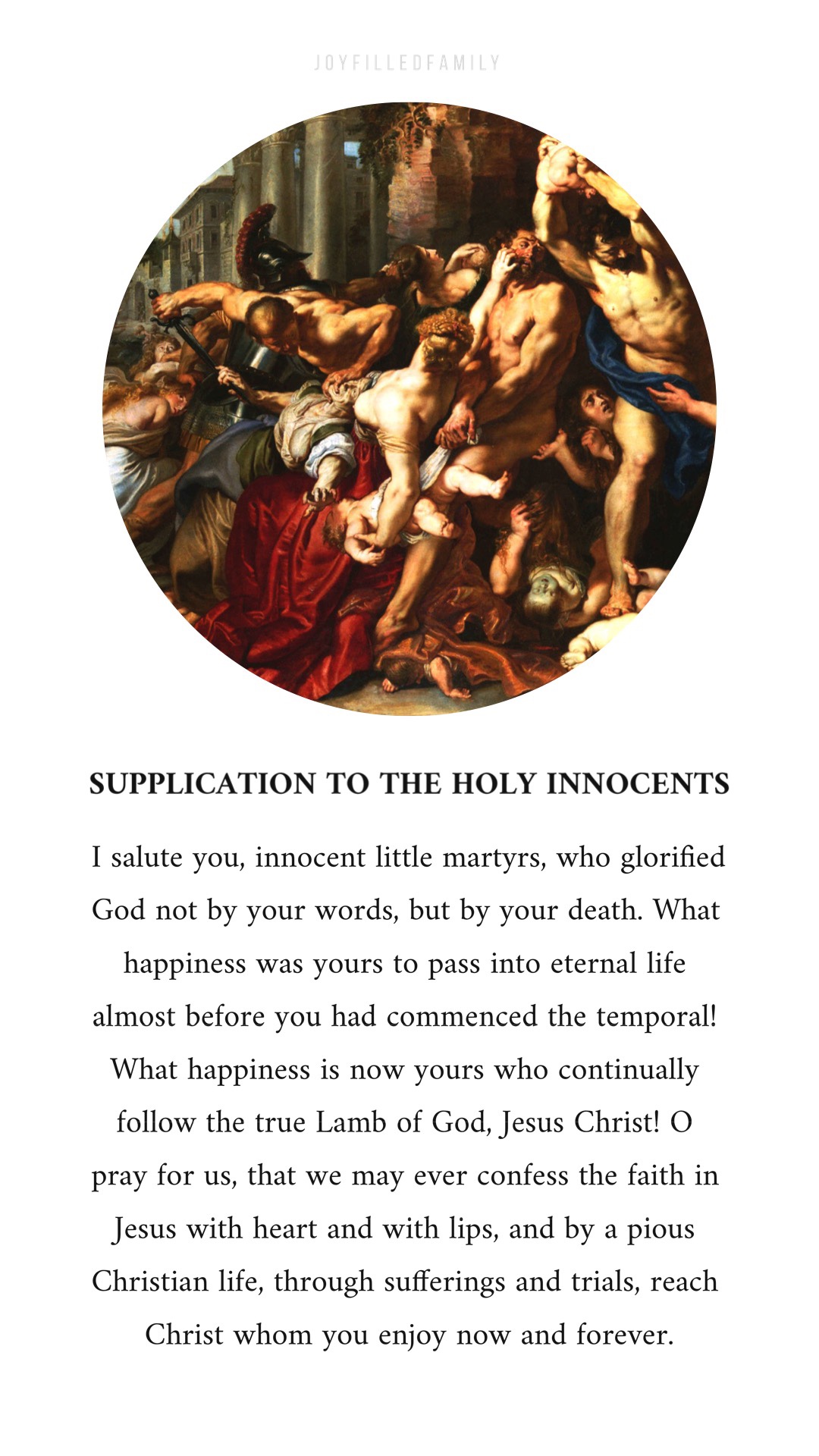
DECEMBER 28
THE HOLY INNOCENTS
Dom Prosper Guéranger
(Anciently ‘Childermas Day’)
The feast of the beloved Disciple is followed by that of the Holy Innocents. The Crib of Jesus – where we have already met and venerated the Prince of Martyrs and the Eagle of Patmos – has today standing round it a lovely choir of little Children, clad in snow-white robes, and holding green branches in their hands. The Divine Babe smiles upon them – he is their King; and these Innocents are smiling upon the Church of God. Courage and Fidelity first led us to the Crib; Innocence now comes, and bids us tarry there.
Herod intended to include the Son of God amongst the murdered Babes of Bethlehem. The Daughters of Rachel wept over their little ones, and the land streamed with blood; but, the Tyrant’s policy can do no more:- it cannot reach Jesus, and its whole plot ends in recruiting an immense army of Martyrs for heaven. These Children were not capable of knowing what an honour it was for them, to be made victims for the sake of the Saviour of the world; but, the very first instant after their immolation, and all was revealed to them: they had gone through this world without knowing it, and now that they know it, they possess an infinitely better. God showed here the riches of his mercy – he asks of them but a momentary suffering, and that over, they wake up in Abraham’s Bosom: no further trial awaits them, they are in spotless innocence, and the glory due to a soldier who died to save the life of his Prince, belongs eternally to them.
They died for Jesus’ sake – therefore, their death was a real Martyrdom, and the Church calls them by the beautiful name of The Flowers of the Martyrs, because of their tender age and their innocence. Justly, then, does the ecclesiastical Cycle bring them before us today, immediately after the two valiant Champions of Christ, Stephen and John. The connection of these three Feasts is thus admirably explained by St. Bernard: “In St Stephen, we have both the act and the desire of Martyrdom; in St. John, we have but the desire; in the Holy Innocents, we have but the act. … Will any one doubt whether a crown was given to these Innocents? … If you ask me what merit could they have, that God should crown them? let me ask you, what was the fault, for which Herod slew them? What! is the mercy of Jesus less than the cruelty of Herod? and whilst Herod could put these Babes to death, who had done him no injury, Jesus may not crown them for dying for Him?
“Stephen, therefore, is a Martyr, by a Martyrdom of which men can judge, for he gave this evident proof of his sufferings being felt and accepted, that, at the very moment of his death, his solicitude both for his own soul and for those of his persecutors increased; the pangs of his bodily passion were less intense than the affection of his soul’s compassion, which made him weep more for their sins than for his own wounds. John was a Martyr, by a Martyrdom which only Angels could see, for the proofs of his sacrifice being spiritual, only spiritual creatures could ken them. But, the Innocents were Martyrs to none other eye save thine, O God! Man could find no merit; Angel could find no merit: the extraordinary prerogative of thy grace is the more boldly brought out. From the mouth of the Infants and the Sucklings thou hast perfected praise. [Ps. viii. 3.] The praise the Angels give thee, is: Glory be to God in the highest, and peace on earth to men of good will: [St. Luke, ii. 14.] it is a magnificent praise, but I make bold to say, that it is not perfect, till He cometh who will say: ‘Suffer Little Children to come unto me, for of such is the kingdom of heaven;’ [St Matth. xix. 14.] and in the mystery of my mercy, there shall be peace to men that cannot even use their will.” (Sermon for the Feast of the Holy Innocents.)
Yes, God did for these Innocents, who were immolated on his Son’s account, what he is doing every moment now by the sacrament of regeneration, in the case of children, who die before coming to the use of reason. We, who have been baptised by water, should be all the more ready to honour these Little Ones, who were baptised in their own blood, and thereby associated to all the mysteries of the Divine Infancy. We ought, together with the Church, to congratulate them, for that a glorious and premature death secured them their innocence. They have lived upon our earth, and yet it defiled them not! Truly, these tender Lambs deserve to be for ever with the Lamb of God! May this same earth of ours, grown old in wickedness, draw down the divine mercy on itself, by the love and honour it gives, each year, to these sweet Children of Bethlehem, who, like the Dove of Noah’s Ark, could not find whereon to rest their feet.
In the midst of the joy, which, at this holy time, fills both heaven and earth, the Holy Church of Rome forgets not the lamentations of the Mothers, who beheld their Children cruelly butchered by Herod’s soldiers. She hears the wailing of Rachel, and condoles with her; and, unless it be a Sunday, she suspends on this Feast some of the manifestations of the joy, which inundates her soul during the Octave of her Jesus’ Birth. The Red Vestments of a Martyr’s Day would be too expressive of that stream of infant blood which forbids the Mothers to be comforted, and joyous White would ill suit their poignant grief; she, therefore, vests in Purple, the symbol of mournfulness. [Unless it be a Sunday; in which case, the colour used is Red.] The Gloria in excelsis, the Hymn she loves so passionately during these days, when Angels come down from heaven to sing it – even that must be hushed today: and, in the Holy Sacrifice, she sings no Alleluia. In this, as in everything she does, the Church acts with an exquisite delicacy of feeling. Her Liturgy is a school of refined Christian considerateness.
This expression of sympathy gives today’s Office a pathetic sadness, which, however, in no ways interferes with the joy, which the Church feels in celebrating the Feast of the Holy Innocents. She keeps it with an Octave, as she does the two preceding Feasts of St. Stephen and St. John. She sanctions the practice, observed in Cathedral and Collegiate Churches, of allowing young boys to share in the duties of the Choir, and blend their innocent chanting with that of the Ministers of God. She grants them several privileges, and takes pleasure in seeing the delight wherewith these children perform the several functions entrusted to them. This joy, this simplicity, this innocence, all add a charm to the divine Service; and through these youthful Choristers, the Church pays honour to the Infant Jesus, and to the Holy Innocents of Bethlehem.
In Rome, the Station for the Feast of St. Stephen is in the Church dedicated to the holy Protomartyr, on Monte Celio; that for St. John is in the Basilica of St. Mary Major; today, the Station is made at St. Paul’s beyond the Walls, which possessed several of the bodies of the Holy Innocents. In the 16th century, Pope Xystus the Fifth caused a portion of these Relics to be translated to St Mary Major’s, and put near the holy Relic of our Lord’s Crib.
O God, Whose praise the martyred Innocents on this day confessed, not by speaking, but by dying: destroy in us all the evils of sin, that our life also may proclaim by deeds Thy faith which our tongue professes. Through our Lord.

A SIMPLE WAY TO CELEBRATE
- It is custom that the youngest child “rules the day.” It is the youngest who decides the day’s foods, drinks, music, entertainments, etc. Sometimes you can divvy up the day between your younger children. If your youngest is too young to decide on his special interests, select a specific outing/activity that will be especially enjoyed by him.
- To recall the blood of the martyrs, a food with a red color, especially a pudding or ice cream with a red sauce, such as raspberry, is traditional.
- In addition, the Father can formally bless the children. It can be the start of regular blessings for your children if this is not already a practice in your home.

CHILDREN’S BLESSING
Father:
O Lord, hear my prayer.
All:
And let my cry come unto Thee.
Father:
Let us pray. O Lord Jesus Christ, once Thou embraced and placed Thy hands upon the little children who came to Thee, and said: “Suffer the little children to come unto Me, and forbid them not, for theirs is the kingdom of heaven, and their angels always see the face of my Father!” Look now with fatherly eyes on the innocence of these children and their parents’ devotion, and bless them this day through our prayers.
The father signs the forehead of each child with holy water.
Father:
In Thy grace and goodness let them advance continually, longing for Thee, loving Thee, fearing Thee, keeping Thy commandments. Then they will surely come to their destined home, through Thee, Savior of the world. Who lives and reigns forever and ever.
All:
Amen.
Father:
May God bless you. And may He keep your hearts and minds — the Father, Son and the Holy Spirit.
All:
Amen.
- Start a Novena to the Magi in anticipation of the Epiphany. – This Novena is especially prayed beginning on 28 December (the Feast of the Holy Innocents) and ending on 5 January (the Vigil of the Epiphany).

